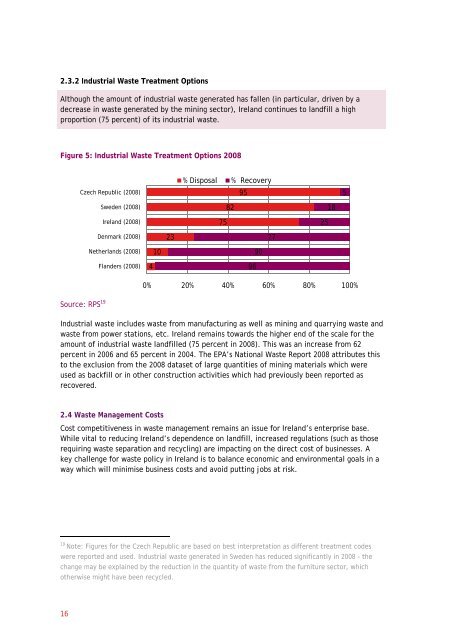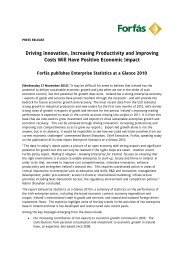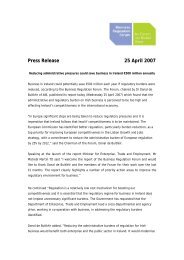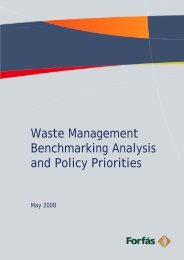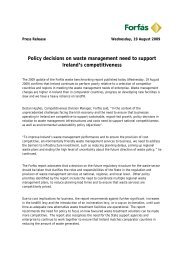Waste Management in Ireland: Benchmarking Analysis and ... - Forfás
Waste Management in Ireland: Benchmarking Analysis and ... - Forfás
Waste Management in Ireland: Benchmarking Analysis and ... - Forfás
You also want an ePaper? Increase the reach of your titles
YUMPU automatically turns print PDFs into web optimized ePapers that Google loves.
2.3.2 Industrial <strong>Waste</strong> Treatment Options<br />
Although the amount of <strong>in</strong>dustrial waste generated has fallen (<strong>in</strong> particular, driven by a<br />
decrease <strong>in</strong> waste generated by the m<strong>in</strong><strong>in</strong>g sector), <strong>Irel<strong>and</strong></strong> cont<strong>in</strong>ues to l<strong>and</strong>fill a high<br />
proportion (75 percent) of its <strong>in</strong>dustrial waste.<br />
Figure 5: Industrial <strong>Waste</strong> Treatment Options 2008<br />
Source: RPS 19<br />
Industrial waste <strong>in</strong>cludes waste from manufactur<strong>in</strong>g as well as m<strong>in</strong><strong>in</strong>g <strong>and</strong> quarry<strong>in</strong>g waste <strong>and</strong><br />
waste from power stations, etc. <strong>Irel<strong>and</strong></strong> rema<strong>in</strong>s towards the higher end of the scale for the<br />
amount of <strong>in</strong>dustrial waste l<strong>and</strong>filled (75 percent <strong>in</strong> 2008). This was an <strong>in</strong>crease from 62<br />
percent <strong>in</strong> 2006 <strong>and</strong> 65 percent <strong>in</strong> 2004. The EPA’s National <strong>Waste</strong> Report 2008 attributes this<br />
to the exclusion from the 2008 dataset of large quantities of m<strong>in</strong><strong>in</strong>g materials which were<br />
used as backfill or <strong>in</strong> other construction activities which had previously been reported as<br />
recovered.<br />
2.4 <strong>Waste</strong> <strong>Management</strong> Costs<br />
Cost competitiveness <strong>in</strong> waste management rema<strong>in</strong>s an issue for <strong>Irel<strong>and</strong></strong>’s enterprise base.<br />
While vital to reduc<strong>in</strong>g <strong>Irel<strong>and</strong></strong>’s dependence on l<strong>and</strong>fill, <strong>in</strong>creased regulations (such as those<br />
requir<strong>in</strong>g waste separation <strong>and</strong> recycl<strong>in</strong>g) are impact<strong>in</strong>g on the direct cost of bus<strong>in</strong>esses. A<br />
key challenge for waste policy <strong>in</strong> <strong>Irel<strong>and</strong></strong> is to balance economic <strong>and</strong> environmental goals <strong>in</strong> a<br />
way which will m<strong>in</strong>imise bus<strong>in</strong>ess costs <strong>and</strong> avoid putt<strong>in</strong>g jobs at risk.<br />
19<br />
Note: Figures for the Czech Republic are based on best <strong>in</strong>terpretation as different treatment codes<br />
were reported <strong>and</strong> used. Industrial waste generated <strong>in</strong> Sweden has reduced significantly <strong>in</strong> 2008 - the<br />
change may be expla<strong>in</strong>ed by the reduction <strong>in</strong> the quantity of waste from the furniture sector, which<br />
otherwise might have been recycled.<br />
16<br />
Czech Republic (2008)<br />
Sweden (2008)<br />
<strong>Irel<strong>and</strong></strong> (2008)<br />
Denmark (2008)<br />
Netherl<strong>and</strong>s (2008)<br />
Fl<strong>and</strong>ers (2008)<br />
4<br />
10<br />
23<br />
% Disposal % Recovery<br />
75<br />
82<br />
95<br />
96<br />
0% 20% 40% 60% 80% 100%<br />
90<br />
77<br />
25<br />
18<br />
5


